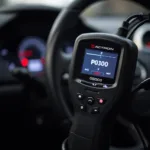The Ford Focus Mk1, a popular car from the late 90s and early 2000s, utilizes the OBD2 protocol for diagnostics. Understanding the ford focus mk1 obd2 protocol is crucial for troubleshooting issues and maintaining optimal performance. This article dives deep into the specifics of the OBD2 system in the Mk1 Focus, providing valuable information for both car owners and professionals.
Understanding the Basics of OBD2 in the Ford Focus Mk1
OBD2, or On-Board Diagnostics II, is a standardized system that allows you to access diagnostic information from your car’s computer. In the Ford Focus Mk1, this system monitors various components, from the engine and transmission to the emissions system. This allows you to identify potential problems early on, saving you time and money on repairs. The ford focus mk1 obd2 protocol uses a standardized connector located under the dashboard, typically near the steering wheel.
Using an OBD2 scanner, you can read diagnostic trouble codes (DTCs), which are specific codes that indicate what’s wrong with your car. These codes, along with live data readings from various sensors, provide valuable insights into the health of your vehicle.
What OBD2 Protocol Does the Ford Focus Mk1 Use?
The Ford Focus Mk1 typically uses the ISO 9141-2 or ISO 14230-4 (KWP2000) protocol. While some models might also use the CAN protocol (Controller Area Network) especially those produced in later years of the Mk1 generation, it is less common. Determining the exact protocol can sometimes require checking with your specific vehicle’s documentation or using a compatible OBD2 scanner that can auto-detect the protocol. Knowing the correct ford focus mk1 obd2 protocol is essential for selecting the right diagnostic tools and interpreting the data correctly.
Common Ford Focus Mk1 OBD2 Trouble Codes
Some common DTCs you might encounter on a Ford Focus Mk1 include P0171 (System Too Lean), P0300 (Random/Multiple Cylinder Misfire Detected), and P0420 (Catalyst System Efficiency Below Threshold). These codes can point to various underlying issues, from vacuum leaks to faulty sensors. Remember, while these are common, the specific codes and their meanings can vary depending on the year and model of your Ford Focus Mk1. Always consult a reliable source for accurate interpretations of your specific codes.
How to Use an OBD2 Scanner on a Ford Focus Mk1
Using an OBD2 scanner on a Ford Focus Mk1 is straightforward. Locate the OBD2 port under the dashboard, plug in your scanner, turn the ignition on (but don’t start the engine), and follow the prompts on your scanner to read codes or access live data.
Conclusion
Understanding the ford focus mk1 obd2 protocol is a powerful tool for any owner. By using an OBD2 scanner, you can gain valuable insights into your vehicle’s health, diagnose problems efficiently, and potentially save money on repairs. Knowing the typical protocols used (ISO 9141-2 or ISO 14230-4) and common trouble codes empowers you to maintain your Ford Focus Mk1 effectively and keep it running smoothly for years to come.
FAQ
- Where is the OBD2 port located in my Ford Focus Mk1? Typically under the dashboard near the steering wheel.
- What protocol does my Ford Focus Mk1 use? Likely ISO 9141-2 or ISO 14230-4.
- What does code P0171 mean? System Too Lean (Bank 1).
- Can I clear codes with an OBD2 scanner? Yes, most scanners allow you to clear codes.
- Do I need a special OBD2 scanner for my Ford Focus Mk1? Not necessarily, but compatibility is important.
- What is live data on an OBD2 scanner? Real-time information from various sensors.
- Is it difficult to use an OBD2 scanner? No, it’s generally very user-friendly.
Need Support? Contact us via WhatsApp: +1(641)206-8880, Email: [email protected] or visit our office at 789 Elm Street, San Francisco, CA 94102, USA. We have a 24/7 customer support team.
